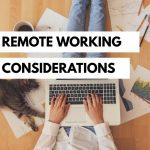How do you move towards the hybrid workplace? Guy Osmond dissects the issue and provides some key pointers to get us started.
2020 brought us disruption on a scale beyond living memory. With the promise of widespread vaccination, UK businesses can finally start to formulate a plan for the future of their workforce and the corporate workplace.
A crucial question at the top of every corporate board’s agenda is ‘how much space do we need?’ They should also be asking, ‘How shall we use our space?’ The first question cannot be answered without a plan for the second. For many employers, the appropriate timescale for any transition will be dependent on lease cycles; but, for all, there are vital questions to be asked immediately.
Inevitably, creating a future homeworking plan will be essential in identifying what corporate space is needed. The scale and apparent ease of homeworking adoption have accelerated a process that might have taken many employers years, rather than months, to embed without the COVID impetus.
However, there are pros and cons to review carefully, especially now that the honeymoon period of enforced homeworking has passed.
Here are my thoughts about some of the issues to address and some pointers on getting started.
Communication
The key to any change management process is excellent communication. Those businesses that have navigated successfully through this year’s challenges will have done so with their personnel’s help and support. Support and goodwill are only maintained through consistent, reliable, transparent communication. They will become even more critical in navigating the post-lockdown changes.
Culture
Do your managers trust their people, and do their people know they are trusted? Central to a successful transition is support for your middle managers who may feel the most threatened by these changes. Typically, they support their teams in new and challenging circumstances while under pressure from their superiors to maintain standards and productivity.
Managing a geographically dispersed team requires different skills and greater trust than when everyone is in the same location. Without trust, nothing works efficiently. If keystroke monitoring or activity tracking software was on your shopping list, then it is time to stop what you are doing and look carefully at your business culture and, probably, your whole recruitment process. It is time to start the cultural transition from management to leadership.
Vocabulary
This point may sound trivial, but you need to be communicating without ambiguity. Are you planning a ‘Hybrid Workplace’ or a ‘Homeworking Program’? These may be terms you see in blogs and magazine articles. They may even be good titles to make you read such articles! But are they relevant to what you plan to do? If your non-office workers are distributed between homes, coffee shops, local hubs, satellite offices, and new ‘third spaces’ not invented yet, do you need a better catch-all term than ‘homeworking’? Bear in mind that the distributed workforce concept is not new, and many employers have been operating ‘agile’ or ‘smarter’ working programs for a decade or more.
Premises
However, much of the corporate real estate you (eventually) decide to retain, the most important issue will be to create an attractive, welcoming, inclusive environment that your people want to visit. The expectation is that many will prefer to continue to work at home for at least part of the week, and those who have now been homeworking for several months will have established a new work-life balance. While some will be desperate to get back to a corporate environment, others will need to be enticed.
Think about what type of work will be done on your premises. Now, most recognize that concentrated, focused work is often done better at home while collaborative, creative work often needs a physical meeting place. What sort of spaces and furniture will you provide? It is becoming evident that rows of legacy desks will not fit the bill (and not just because of social distancing constraints). Look to the hospitality industry for ideas about creating suitable zones and opportunities for collaboration and serendipitous encounters.
Accommodation Utilization
Whether or not you decide that you need less corporate space will be essential to maximize its use. You may well find that three desks per ten employees are sufficient, but you will need to provide an array of other setups to accommodate their various behaviors. An activity-based working approach will help to match needs and resources. Many employers identify personas to classify not only technical needs but space requirements too. Think about providing wi-fi in outside areas as well as all shared spaces.
Train your leaders to manage the timing of meetings and critical collective activities to ensure you don’t find you have only Tuesday-Thursday occupancy. Make no assumptions and think afresh in terms of the new requirements rather than adapting old opinions.
Wellbeing
Over the last several months, there has been a welcome recognition of mental health issues for those working remotely or alone. Rightly, there has been a much more open discussion about stress, anxiety, and depression and ways to address them. Your organization will need a robust and comprehensive wellbeing program to accommodate both mental and physical health needs.
We have already seen that the mental health issues grew again in the second lockdown, not least because of colder, wetter weather and less daylight. We know that mental and physical health are intrinsically connected, and we have also seen an increase in physical health issues and musculoskeletal problems in particular.
In a rush to make the corporate space more dynamic and inviting, do not forget the personnel who have been working for months using unsuitable furniture at inappropriate heights and with insufficient support. They may be out of sight, but they should not be out of mind.
Why not check out our latest course, Personal Wellbeing. It gives employees the tools to lead healthier, happier lives, covering stress management, mindfulness, movement and more. For a demo of the course, use the link below. Click New user? Register. Then create a user ID and add your email address.







